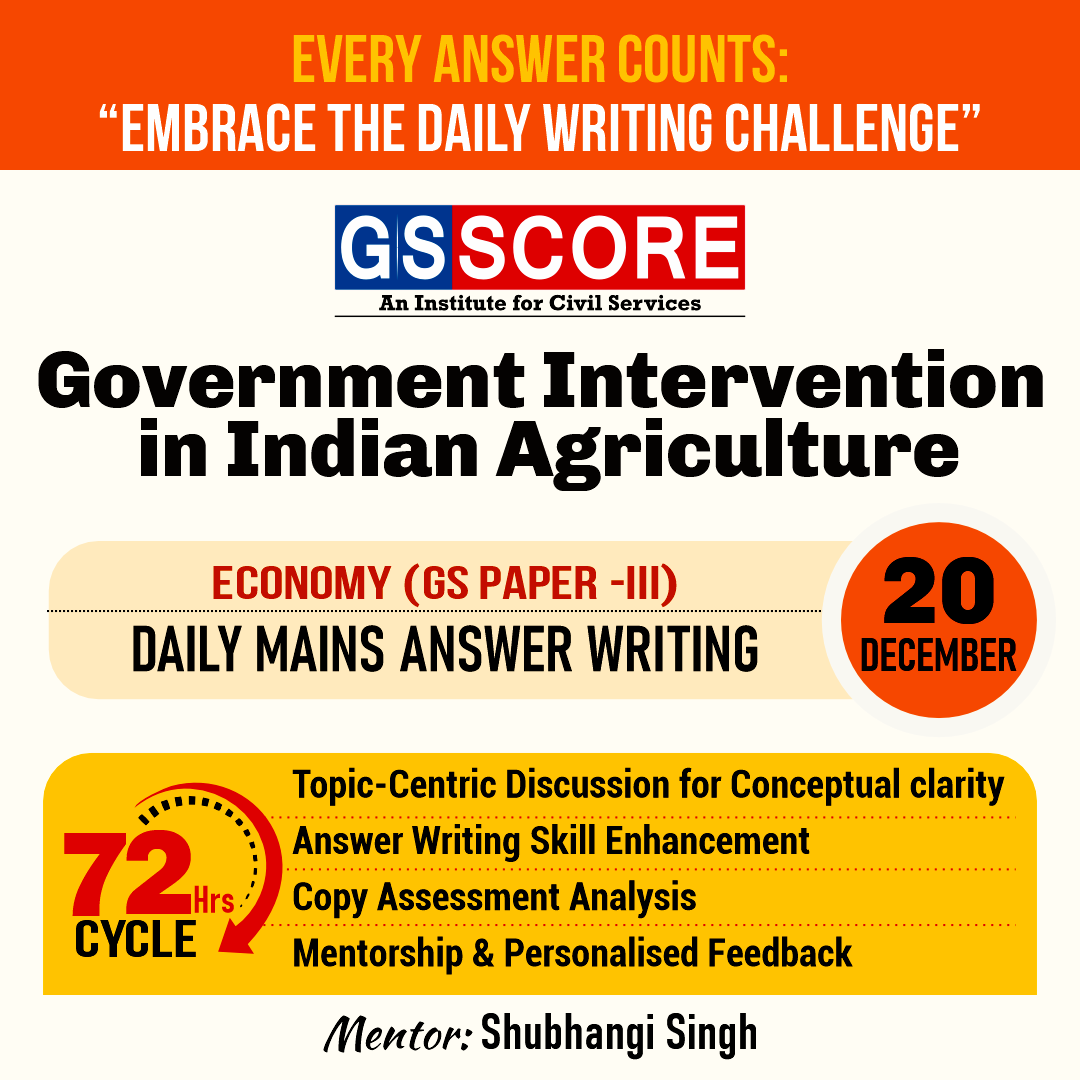


Instruction:
- There will be 2 questions carrying the First Question is-10 marks Write your answers in 150 words and the Second Question is-15 marks Write your answers in 250 words.
- Any page left blank in the answer-book must be crossed out clearly.
- Evaluated Copy will be re-uploaded on the same thread after 2 days of uploading the copy.
- Discussion of the question and one to one answer improvement session of evaluated copies will be conducted through Google Meet with concerned faculty. You will be informed via mail or SMS for the discussion.
Question #1. Government policies and interventions is a key pillar in addressing challenges related to agriculture in India. What measures can be taken to improve the effectiveness of such interventions? 10 marks (150 words)
Question #2. Discuss the role of technology and innovation in government interventions in agriculture. Propose measures to harness technology for sustainable agricultural practices. 15 marks (250 words)
(Examiner will pay special attention to the candidate's grasp of his/her material, its relevance to the subject chosen, and to his/ her ability to think constructively and to present his/her ideas concisely, logically and effectively).
STEPS & INSTRUCTIONS for uploading the answers
Step 1 - The Question for the day is provided below these instructions. It will be available at 7:00 AM.
Step 2 - Uploading of Answers : Write the answer in A4 Sheet leaving proper margins for comments and feedback and upload the PDF in MY ACCOUNT section. Click on the option of SUBMIT COPY to upload the PDF.
Step 3 - Deadline for Uploading Answers: The students shall upload their answers by 7:00 PM in the evening same day. The first 50 copies will be evaluated.
Step 4 - Feedback : Mentors will give their feedback for the answers uploaded. For more personalised feedback, join our telegram channel by clicking on the link https://t.me/mains_answer_writing_cse . A one-to-one session will be conducted with the faculty after copy evaluation in 72 Hrs.
Model Answer
Question #1. Government policies and interventions is a key pillar in addressing challenges related to agriculture in India. What measures can be taken to improve the effectiveness of such interventions? 10 marks (150 words)
Hints –
Government policies and interventions play a pivotal role in addressing multifaceted challenges like rural distress, farmer suicides, and agrarian crises in India. These issues are often interconnected, stemming from factors such as inadequate income, indebtedness, crop failure, and lack of social and financial support. Analyzing the effectiveness of existing interventions and proposing measures for improvement is crucial.
Price Assurance and Income Support
- Pradhan MantriKisanSammanNidhi (PM-KISAN):
- Provides ?6,000 per year to small and marginal farmers.
- Effective but needs expanded coverage and increased financial assistance.
- Minimum Supprt Price:
- It provides price assurance, especially for crops that may face market price fluctuations.
- The Commission for Agricultural Costs & Prices (CACP) recommends MSPs for 22 mandated crops and fair and remunerative price (FRP) for sugarcane.
- Loan Waiver Schemes:
- Implemented by states to address farmer indebtedness.
- Advocates for sustainable solutions like strengthening institutional credit mechanisms.
Addressing Farmer Suicides
- Financial Interventions
- Loan waivers as a temporary relief measure.
- Emphasizes the need for sustainable solutions like promoting formal credit mechanisms.
- Financial Literacy and Farmer Producer Organizations (FPOs)
- Promoting FPOs and enhancing financial literacy.
- Aims to reduce reliance on informal credit and prevent overindebtedness.
Crop Insurance
- Pradhan MantriFasalBimaYojana (PMFBY)
- Designed to mitigate financial risks due to crop failure.
- PMFBY provides a comprehensive insurance cover against failure of the crop thus helping in stabilising the income of the farmers.The Scheme covers all Food & Oilseeds crops and Annual Commercial/Horticultural Crops
Sustainable Agricultural Practices
- ParamparagatKrishiVikasYojana (PKVY) and Organic Farming:
- Encourages sustainable farming practices.
- Addresses environmental concerns and enhances farm incomes.
Measures for Improvement
- Integrated Approach:
- Holistic solutions that integrate various schemes and initiatives.
- Promotes synergies for a more comprehensive impact.
- Technological Solutions:
- Incorporation of technology in agriculture.
- Enhances efficiency, productivity, and access to market information.
- Community-Based Initiatives:
- Encouragement of community-led projects.
- Fosters local empowerment and collective problem-solving.
While government interventions have addressed certain aspects of rural distress, a holistic and integrated approach is needed. Strengthening existing schemes, incorporating technological solutions, and fostering community-based initiatives can collectively contribute to building a more resilient and prosperous agrarian sector in India.
Question #2. Discuss the role of technology and innovation in government interventions in agriculture. Propose measures to harness technology for sustainable agricultural practices. 15 marks (250 words)
Hints –
Government interventions in agriculture have witnessed significant strides with the integration of technology and innovation. These advancements play a crucial role in addressing multifaceted challenges such as rural distress, farmer suicides, and agrarian crises. Examining the current landscape reveals both successes and areas that demand improvement.
Role of Technology and Innovation in Agriculture:
- Pradhan MantriKisanSammanNidhi (PM-KISAN):
- Technology Integration: Utilizing digital platforms for efficient disbursement of ?6,000 annually to small and marginal farmers.
- Potential Enhancement: Implementing blockchain or smart contract technology for transparent and direct fund transfers, reducing intermediaries.
- Minimum Support Price (MSP):
- Digital Agriculture Platforms: Integrating technology for real-time information on market prices, enabling farmers to make informed decisions.
- Precision Farming: Promoting innovative farming techniques like precision agriculture to optimize resource utilization and enhance yields.
- Loan Waiver Schemes:
- Digital Credit Platforms: Implementing online credit systems for easy accessibility, reducing the dependency on informal credit.
- Fintech Solutions: Collaborating with financial technology companies to offer customized loan products and debt management tools.
- ParamparagatKrishiVikasYojana (PKVY) and Organic Farming:
- IoT in Agriculture: Implementing Internet of Things (IoT) devices for smart farming practices, monitoring soil health, and optimizing resource usage.
- Training through Apps: Developing mobile applications for disseminating information on organic farming practices and sustainable agricultural techniques.
Proposed Measures for Harnessing Technology:
- Unified Agricultural Information System: Creating a comprehensive digital platform integrating various schemes, providing farmers with a one-stop solution for information and services.
- Interoperability: Ensuring compatibility and data-sharing capabilities among different agricultural technologies and platforms.
- Farm Mechanization: Encouraging the adoption of modern farming equipment, reducing dependency on manual labor, and enhancing productivity.
- Smart Irrigation Systems: Introducing sensor-based irrigation systems for optimal water usage, mitigating water-related challenges.
- Digital Farmer Producer Organizations (FPOs): Empowering FPOs with digital tools for collective decision-making, market access, and resource optimization.
- Crowdsourced Agricultural Solutions: Encouraging community participation in identifying and solving local agricultural challenges through digital platforms.
In conclusion, the integration of technology and innovation in government interventions is pivotal for creating a sustainable agricultural ecosystem. Embracing digital solutions, promoting precision farming, and fostering community engagement will not only address existing challenges but also pave the way for a resilient and tech-enabled agrarian sector in India.

